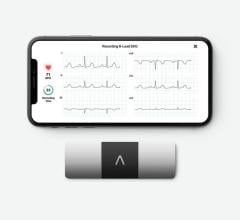
September 19, 2022 — HeartBeam, Inc. (NASDAQ: BEAT), a cardiac technology company that has developed the first and only 3D-vector ECG platform for heart attack detection anytime, anywhere, announced today that its patent for a 12-lead electrocardiogram (ECG) patch monitor intended for detection of acute coronary syndrome (ACS) and cardiac arrhythmia was issued by the United States Patent and Trademark Office. The innovation builds on HeartBeam’s growing intellectual property portfolio enabling 12-lead ECG diagnostics outside of a medical setting.
The global ECG patch monitor market, estimated to reach $4.8B by 2030, is currently limited to arrhythmia detection via the use of single-lead ECG devices. By elevating patch monitor technology with a synthesized 12-lead ECG, HeartBeam can aid physicians in both arrhythmia detection and ACS diagnosis including myocardial infarction (heart attack) and angina.
“This patent provides additional intellectual property protection for our breakthrough ECG patch technology, offering 12-lead ECG capability in the form of a simple patch that is similar in size and shape to existing single-lead ECG patch monitors in the market today,” said HeartBeam CEO and Founder Branislav Vajdic, PhD. “Our 12-lead ECG patch technology offers the potential to bring a level of diagnostic accuracy consistent with the current 12-lead ECG standard of care and could have a disruptive effect on the ECG patch market with its ischemia detection capability.”
The newly issued patent (No. 11,419,538 B2) expands on the HeartBeam’s previously granted US patent (No. 11,071,490 B1) for a 12-lead ECG patch monitor technology. The patch patent follows HeartBeam’s already granted core patents for remote detection of heart attacks. These two issued patch patents significantly increase HeartBeam’s intellectual property footprint, and they further widen the impact HeartBeam’s technology could have on cardiac patients and their physicians.
“The ECG monitors available today are primarily used for detection of abnormal heart rhythms associated with atrial fibrillation or syncope,” said Martin Burke, DO, FACC, cardiac electrophysiologist and chief scientific officer of the CorVita Science Foundation, which holds The Rory Childers Electrocardiology Research Center and Fellowship program. “A 12-lead ECG patch would provide additional information to aid in diagnosing conditions such as ACS or more specific arrhythmias that current single-lead patches cannot accurately detect.”
For more information: www.heartbeam.com


 November 21, 2023
November 21, 2023 








